Return to Rainforest Floor
OR
Return to Rainforest Plants\Trees
Figs Figs, Ficus spp. This genus contains about 1000 different species found worldwide, including as potted plants in many households. They are of one of the best known and widespread of all plant genera. In fact, Figs are considered by some authors to be the most diverse genus of woody plants when looking at habit, growth forms and life forms (Kalko et al 1996). And because the genus is ubiquitous in all the world's rain forests, it is often studied, and has some important and fascinating ecology.
Growth forms Many figs start off as mere epiphytes, with the 'strangler' forms of many species having their fruits deposited in the top of a canopy by a fig eating animal and then grow their roots down around a host tree. Some species of figs in the Australian rainforests have evolved the unusual habits of 'ramiflory' and 'cauliflory', the fruiting on the branches and the main trunk respectively.
Figs pollination Figs do not have flowers in the traditional sense, for the tiny reproductive parts are hidden inside round receptacles that we normally recognize as the ‘fruit’. Figs have a highly specific and reliant relationship with 'fig wasps' of the family Agaonidae: the tiny flowers of each particular species of fig are pollinated only by another particular species of 'fig wasp', while the wasps rely on the receptacle to reproduce inside (Compton et al 1996).
Regular supply of Fruits Because of this relationship, it is thought figs have to provide these fruit receptacles more or less continously, and thus many figs fruit asynchronously. That is, trees fruit out of sync with other individuals of the same species (Kalko e al 1996). This also means that figs are being produced all year round, and thus can provide a regular food source for many animals in the rainforest; this is especially important when food is scarce at certain times of the year. And thus figs are often considered 'keystone' species. They have traditionally been thought of as providing fruits mainly for generalist fruit eaters, and over 50 species of birds in Australia have been recorded feeding on fig fruits (Green 1993). However more recently it has been acknowledged that some figs may target specific dispersers and that there are some animals that may almost entirely feed on figs. It is no accident that some Australian birds have the 'fig' prefix in their common name, such as the 'Fig Parrot' and the 'Fig Bird'; the latter bird is thought to be almost an obligate fig eater (Green 1993).
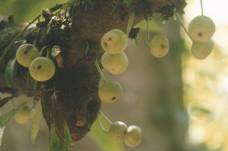
The 'Plentiful Fig', Ficus copiosa is a tree, not a strangler, that often has sandpapery leaves. It produces quite attractive fruits that are large and light green, sometimes with a little rough brown hair. The fruits can be produced along the stem and trunk (left).
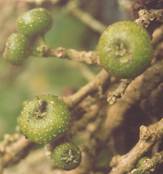
The 'Hairy Fig' Ficus hispida gets it's common name from it's fruit. They are small, round but slightly flattened, green or yellow fruits with pale speckles and, most distinctively, a sparse but roughly hairy surface that feels like an unshaven face (right).
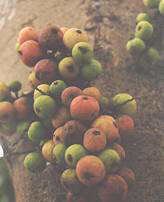
The 'Cluster Fig', Ficus racemosa is so-called due to the often large 'clusters' of fruit that appear on the main trunk and branches (left). They ripen from green to yellow to red and are not too bad to taste when soft. This large tree is found along watercourses in the lowlands, as well across northern Australia and up into south-east Asia.

The 'Climbing fig', Ficus pantoniana, (left) is actually, as the name suggests, a fig vine, although it is not a strangler. It has small longish leaves which when torn have the distinctive sap of the genus.
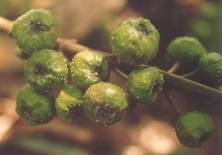
The 'Septic Fig', Ficus septica is usually a tree, and not a strangler. The fruits are found growing on the branches and the trunk, sometimes quite low down. The fruits are greenish at first, often ripening to a lighter green or yellow (right). They are round with a flattened top and covered in small brown dot bumps. This adaptable fig is also found in South-east Asia.
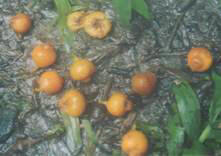
Script and Photos: Courtesy of Damon Ramsey BSc.(Zool) Biologist Guide |
